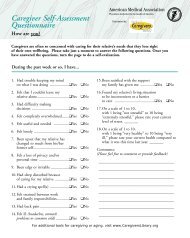MILES AWAY: - National Alliance for Caregiving
MILES AWAY: - National Alliance for Caregiving
MILES AWAY: - National Alliance for Caregiving
Create successful ePaper yourself
Turn your PDF publications into a flip-book with our unique Google optimized e-Paper software.
Table 10. Average Distance <strong>for</strong> Respondent Groups Reporting Work Effects<br />
Work Adjustment<br />
(No./Average Miles) <strong>for</strong> Caregiver<br />
Who Experienced Adjustment<br />
(No./Average Miles) <strong>for</strong> Caregiver<br />
Who Had Not<br />
Came in Late/Left Early<br />
Took Unpaid Leave<br />
Turned Down a Promotion<br />
Turned Down Work Travel<br />
Lost Benefits at Work<br />
Missed Days of Work<br />
Considered Leaving Work<br />
Moved From Full-Time to Part-Time<br />
Considered Changing Employers<br />
Turned Down a Relocation<br />
Rearranged Work Schedule<br />
328 Miles<br />
743 Miles<br />
621 Miles<br />
607 Miles<br />
670 Miles<br />
548 Miles<br />
492 Miles<br />
473 Miles<br />
493 Miles<br />
404 Miles<br />
476 Miles<br />
490 Miles<br />
410 Miles<br />
447 Miles<br />
438 Miles<br />
444 Miles<br />
393 Miles<br />
448 Miles<br />
449 Miles<br />
447 Miles<br />
451 Miles<br />
429 Miles<br />
For those who had to rearrange their work schedule,<br />
the average distance was no different than <strong>for</strong><br />
those who did not. Similarly, those who reported<br />
they turned down relocation were similar to those<br />
who did not in terms of distance from the care<br />
recipient.<br />
Gender and Long-Distance<br />
<strong>Caregiving</strong><br />
In our sample of long-distance caregivers we<br />
had more men than women completing the survey.<br />
This is likely an artifact of the larger sample<br />
characteristics. Nonetheless, previous research on<br />
long-distance caregiving suggests that men may<br />
be more likely than women to identify themselves<br />
as long-distance caregivers. We were interested in<br />
looking at the extent gender played a role in the<br />
overall care activities as well as care effects. We<br />
did find some interesting patterns.<br />
There was no real difference between men and<br />
women in terms of the distance they lived from<br />
the person they were helping (males lived an<br />
average of 452 miles from the person they were<br />
helping; females, an average of 446 miles.) There<br />
were, however, differences in the care situation and<br />
selected work-related factors.<br />
Women reported missing more hours of work per<br />
month as a result of caregiving (24 hours) than<br />
men (17 hours). Women also reported spending<br />
more time helping the care recipient around their<br />
home and with personal care. Women reported<br />
an average of 23.5 hours a month helping around<br />
the home compared to men who reported 21 hours<br />
a month in this activity. Women reported 14.5<br />
hours a month helping with personal care and<br />
men reported 11 hours. And, on average, women<br />
spent more money each month on services needed<br />
by the care recipient ($751) than men ($490).<br />
And, finally, women were more likely than men to<br />
report that they were the only helper or the main<br />
helper in the care situation.<br />
11









